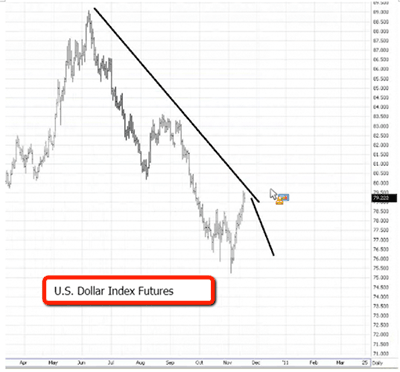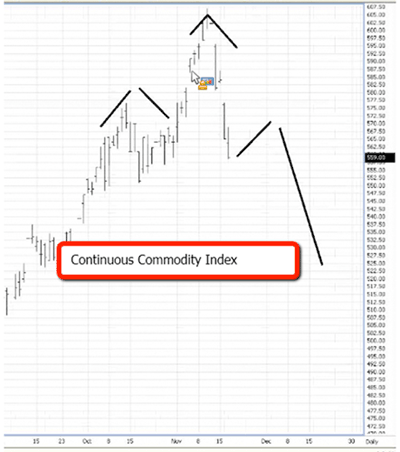By Phil Streible of Lind-Waldock
Gold has backed off a bit after reaching new record highs above $1,400 an ounce this month, but I think the bullish trend for gold should remain intact in 2011. This temporary correction in metals offers a good opportunity to take advantage of the next potential move up with a savvy long-term options strategy.
There are several factors driving the gold market. Gold is a hard asset that acts as a currency and as an inflation hedge.
The Federal Reserve’s second round of quantitative easing known as QE2 was announced at the Fed’s November 3 policy meeting, and the amount of Treasury purchases ($600 billion) was smaller than expected. That has provided some support for a bounce in the US dollar. There has been market speculation that the Fed’s monetary stimulus will fail to provide job growth, which sent ripples through Wall Street.
The euro zone meltdown has provided support to gold and the dollar, both of which benefit from safe-haven buying. We saw this intensify in the spring and summer as Greece faced a potential debt default, and in recent days, Ireland’s financial problems have come to the forefront.
Whether Ireland receives a bailout, and whether they will make necessary budget cuts and adhere to austerity measures both remain question marks. Investors are also wondering which other countries in the euro zone will be next to fall. That has resulted in a new wave of selling in the euro, thus boosting the dollar.
Typically, a weak dollar tends to inflate commodities, which are priced in dollars. While gold is a unique, hybrid asset, weakness in the dollar should still have a price impact. A daily chart of the dollar index futures shows the downward trend and recent uptick in November, but I still see the overall trend as being bearish.
NEXT: China's Impact on Commodities; Gold Option Strategy for 2011
|pagebreak|China has been another big factor impacting gold and other commodity markets in recent days. China is concerned about inflation and has been engaging in tightening measures and curbs on speculation. China’s inflation rate hit 4.4% in October, and analysts expect next year’s average to come in at 5.5%. The People’s Bank of China raised reserve requirements for banks 50 basis points this week, and many market participants see an interest rate increase as inevitable. China is a huge commodity user, and these measures have spurred corrections in commodity prices, including metals.
On a chart of the continuous commodity index (a basket of 17 different commodity futures), you can see a possible head-and-shoulders pattern, and a completion of this pattern suggests a further selloff in commodities, including gold. I think savvy participants holding both dollars and/or euro are likely to move into gold as prices drop, as well as energies and perhaps agricultural markets with signs of tight supply. I believe the bull run in commodities is not over and the year-end correction should prove to be a temporary pause. Despite some cooling in China, there is still a case to be made for owning gold.
Gold Options Strategy
As many of the factors driving gold in 2010 are likely to continue in 2011, I expect gold to move to $1,450 - $1,500 per ounce. That being the case, I am recommending a long-term bullish gold options strategy.
Buy one 1400 June call
Sell one 1450 June call
These options expire on May 25, 2011. This strategy offers you flexibility in that you can weather a short-term correction without getting knocked out of your bullish trade. A 1450/1500 December 2011 call spread might also be appropriate if you have an even longer time horizon.
Feel free to contact me with any questions you have about the markets, and to develop a customized trading strategy based on your unique goals and risk tolerance.
By Phil Streible of Lind-Waldock
Phil Streible is a senior market strategist with Lind-Waldock. He can be reached at 800-803-8037 or via e-mail pstreible@lind-waldock.com.
Futures trading involves substantial risk of loss and is not suitable for all investors. Past performance is not necessarily indicative of future trading results. Trading advice is based on information taken from trade and statistical services and other sources that Lind-Waldock believes are reliable. We do not guarantee that such information is accurate or complete and it should not be relied upon as such. Trading advice reflects our good faith judgment at a specific time and is subject to change without notice. There is no guarantee that the advice we give will result in profitable trades. All trading decisions will be made by the account holder























